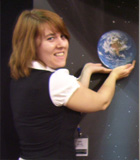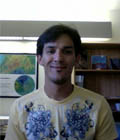
|
Dave Horvath - Postdoc
Dave is working on the hydrology and volcanology of Mars and the hydrology of Titan. He has used hydrological models to reconstruct
the past climate and environmental conditions in Gale Crater on Mars, where the Curiosity rover is now exploring.
He is also studying the most recent volcanic eruption yet documented on Mars, located in the Cerberus region. Dave got
his PhD in Colorado studying the methane hydrology of Titan. Dave is currently a
research scientist at the Planetary Science Institute.
|

|
Pranabendu Moitra - Postdoc
Pranabendu is a volcanologist, interested in explosive volcanic eruptions on Earth and Mars. He did
his PhD at Rice University, focused on basaltic plinian eruptions on Earth. Pranabendu's research focuses on the mechanism behind explosive eruptions on Mars. He is now a research scientist in the Department of Geosciences at the University of Arizona.
|

|
Alex Evans - Postdoc
Alex worked in the group from 2015-2018, studying the geophysics of the Moon and Mars. He used gravity data from the GRAIL mission to reveal a hidden population of impact craters beneath the lunar maria. He then used models to investigate the interplay between climate and volcanism on Mars. His work is showing how deposition of glaciers high on martian volcanoes in the past may have triggered explosive volcanic eruptions. He is now an Assistant Professor at Brown University. |

|
Alejandro Soto - Postdoc
Alejandro worked in the group in 2012, after getting his PhD from Caltech. He used general circulation models to study the ancient climate of Mars.
By forcing the climate to be warmer and wetter, as indicated by the geology, he was able to reconstruct the
distribution of rainfall across the surface, to relate to ancient sedimentary deposits. He is now a research
scientist at the Southwest Research Institute, and continues to collaborate with our group. |

|
Johanna JJ Jansen - Graduate student
JJ got her PhD in 2017, studying the gravity field of the Moon. She analyzed the pervasive small-scale
gravity anomalies that reveal information about the heterogeneity of the upper crust. She also discovered
a set of gravity anomalies radiating out from the Orientale impact basin, related to the ejecta of that basin. |

|
Dave Horvath - Graduate student
Dave earned his PhD in 2017 studying the hydrology of Saturn's moon Titan. He found that subsurface flow of
methane plays a critical role in Titan's hydrological cycle, like water does on Earth and Mars.
He then re-joined the group as a post-doc.
|

|
Kelsey Zabrusky - Graduate student
Kelsey earned her MS in 2011. Her research is focused on reconstructing
ancient sedimentary deposits on Mars. The surprising result: there's much more to Mars' sedimentary record than meets the eye!
|

|
Ezgi Karasozen - Graduate student
Ezgi earned her MS in 2013. She studied the South Tharsis Ridge Belt - a band of mountains resembling the
basin and range province in the southwestern US. She found that these mountains likely formed from ancient
extension during the earliest stages of the formation of the enormous Tharsis volcanic rise.
|

|
Brian Davis - Graduate student
Brian earned his MS in 2013 studying martian tectonics. He showed how the enormous Valles Marineris canyons
on Mars were filled with sediment, and then emptied out by erosion. The response to this erosion can be seen
in gravity, topography, and tectonics around the canyons.
|

|
Yaser Kattoum - Graduate student
Yaser earned his MS in 2012. He studied gravity data from the Moon over the Orientale impact basin. His work was
the first to show evidence for ring faults surrounding the basin that cut down to the base of the crust.
|

|
Hank Cole - Undergraduate student
Hank was an undergraduate research assistant studying martian tectonics. He found a wrinkle ridge thrust fault
exposed as a ridge jutting out into the Valles Marineris canyons. He was able to measure the dip of the fault,
provide the first direct measurement of a fault dip on Mars and providing important information about this
most common fault type in the solar system.
|

|
Ryan Isherwood - Undergraduate student
Ryan studied Olympus Mons - the tallest volcano on Mars (and in the solar system). He used an ancient lava
flow to reconstruct the paleo-topography around the volcano. From that, he used models of the deformation of
the surface in response to the load of the volcano to reconstruct the history of volcanic loading. The surprising
result was that Olympus Mons was older than anyone thought!
|

|
Lauren Jozwiak - Undergraduate student
Lauren studied Olympus Mons on Mars. She studied lava flows around the volcano to identify ones that appear
to not flow down-hill. These lava flows tell us how the topography has changed over time in response to
loading and deformation by the volcano itself. Lauren went on to get her PhD from Brown University.
|

|
Joyce Hoopes - Undergraduate student
Joyce worked with the group as a research assistant. Her work has
included analyzing MOLA topography data and high resolution images from the HiRISE camera to study
sedimentary deposits on Mars, measuring martian faults in MOLA topography, and studying the
topography and hydrology of Saturn's moon Titan.
|


















